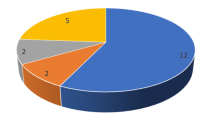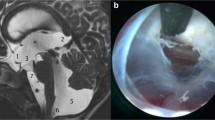Abstract
Background
Trapped fourth ventricle (TFV) is a rare and difficult to treat condition. Most patients have a past inciting event (infection, IVH, trauma) and history of prior CSF diversion. The symptoms are due to the mass effect on brainstem and cerebellum. Rarely, TFV can also be associated with syrinx formation due to a dissociated craniospinal CSF flow near the fourth ventricle outlets. We present our experience and outcomes of open posterior fenestration in 11 cases, along with an overview of the surgical management of TFV.
Methods
Between 2011 and 2018, 11 patients of TFV were operated by the posterior approach fenestration of the fourth ventricle outlets and arachnoid dissection. The clinical and radiological findings of the patients were retrieved from the hospital database. The surgical technique is described in detail. The patients’ neurological status and imaging findings in the follow-up were recorded and compared.
Results
The average age of the patients was 23.55 years. The most common presenting symptoms were headache (9/11) and gait imbalance (7), with TB meningitis being the commonest etiology. Ten patients had a history of prior CSF diversion with two presenting with shunt malfunction. Mean follow-up duration was 33.33 months. The improvement in neurological status was observed in 9/11 patients, 2 remained status quo. On follow-up imaging, 8/11 (72.72%) patients had a decrease in the size of TFV while syrinx improved in 3/5 (60%).
Conclusion
Multiple surgical approaches have been described for TFV. Endoscopic fourth ventriculostomy with aqueductoplasty is gaining popularity in the past two decades. However, an open posterior fenestration of the midline fourth ventricle outlet (magendieplasty) along with sharp arachnoid dissection (adhesiolysis) along the cerebello-medullary cisterns and paracervical gutters is relatively simple and provides physiological fourth ventricular CSF outflow. This is especially useful in TFV with syrinx as the craniospinal CSF circulation is established.



Similar content being viewed by others
References
Cinalli G (2014) Endoscopic aqueductoplasty and placement of a stent in the cerebral aqueduct in the management of isolated fourth ventricle in children. https://doi.org/10.3171/ped.2006.104.1.21
Colpan ME, Savas A, Egemen N, Kanpolat Y (2003) Stereotactically-guided fourth ventriculo-peritoneal shunting for the isolated fourth ventricle. Minim Invasive Neurosurg 46(1):57–60
Dandy EW (1920) The diagnosis and treatment of hydrocephalus resulting from strictures of the aqueduct of Sylvius. SurgGynecolObstet 31:340–345
Dollo C, Kanner A, Siomin V, Ben-Sira L, Sivan J, Constantini S (2001) Outlet fenestration for isolated fourth ventricle with and without an internal shunt. Childs Nerv Syst 17(8):483–486
Ferrer E, de Notaris M (2013) Third ventriculostomy and fourth ventricle outlets obstruction. World Neurosurg 79(2):S20.e9–S20.e13
Foltz EL, Shurtleff DB (1966) Conversion of communicating hydrocephalus to stenosis or occlusion of the aqueduct during ventricular shunt. J Neurosurg 24(2):520–529
Fritsch MJ, Kienke S, Manwaring KH, Mehdorn HM (2004) Endoscopic aqueductoplasty and interventriculostomy for the treatment of isolated fourth ventricle in children. Neurosurgery 55(2):372–377 discussion 377-9
Gallo P, Hermier M, Mottolese C, Ricci-Franchi A-C, Rousselle C, Simon E, Szathmari A (2012) The endoscopic trans-fourth ventricle aqueductoplasty and stent placement for the treatment of trapped fourth ventricle: long-term results in a series of 18 consecutive patients. Neurol India 60(3):271
Garber ST, Riva-Cambrin J, Bishop FS, Brockmeyer DL (2013) Comparing fourth ventricle shunt survival after placement via stereotactic transtentorial and suboccipital approaches. J Neurosurg Pediatr 11(6):623–629
Garg RK, Malhotra HS, Gupta R (2015) Spinal cord involvement in tuberculous meningitis. Spinal Cord 53:649–657
Hall TR, Choi A, Schellinger D, Grant EG (1992) Isolation of the fourth ventricle causing transtentorial herniation: neurosonographic findings in premature infants. Am J Roentgenol 159(4):811–815
Harter D (2004) Management strategies for treatment of the trapped fourth ventricle. Childs Nerv Syst 20(10):710–716
Hawkins JC, Hoffman HJ, Humphreys RP (1978) Isolated fourth ventricle as a complication of ventricular shunting. J Neurosurg 49(6):910–913
Kaynar MY, Koçer N, Gençosmanoğlu BE, Hancı M (2000) Syringomyelia - as a late complication of tuberculous meningitis. Acta Neurochir 142(8):935–939
Lee M, Leahu D, Weiner HL, Abbott R, Wisoff JH, Epstein FJ (1995) Complications of fourth-ventricular shunts. Pediatr Neurosurg 22(6):309–314
Longatti P, Fiorindi A, Feletti A, Baratto V (2006) Endoscopic opening of the foramen of Magendie using transaqueductal navigation for membrane obstruction of the fourth ventricle outlets. J Neurosurg 105(6):924–927
Longatti P, Fiorindi A, Martinuzzi A, Feletti A (2009) Primary obstruction of the fourth ventricle outlets. Neurosurgery 65(6):1078–1086
Matula C, Reinprecht A, Roessler K, Tschabitscher M, Koos WT (1996) Endoscopic exploration of the IVth ventricle. Minim Invasive Neurosurg 39(3):86–92
Mohanty A, Manwaring K (2018) Isolated fourth ventricle: to shunt or stent. Oper Neurosurg 14(5):483–493
Montes JL, Clarke DB, Farmer JP (1994) Stereotactic transtentorial hiatus ventriculoperitoneal shunting for the sequestered fourth ventricle. J Neurosurg 80(4):759–761
Orakdogen M, Emon ST, Erdogan B, Somay H (2015) Fourth ventriculostomy in occlusion of the foramen of magendie associated with Chiari Malformation and Syringomyelia. NMC Case Rep J 2(2):72
Raimondi AJ (1987) Pediatric neurosurgery : theoretical principles art of surgical techniques. Springer, New York
Rajshekhar V (2009) Management of hydrocephalus in patients with tuberculous meningitis. Neurol India 57(4):368–374
Teo C, Burson T, Misra S (1999) Endoscopic treatment of the trapped fourth ventricle. Neurosurgery 44(6):1257–1262
Tyagi G, Bhat DI, Devi BI, Shukla D (2019) Multiple remote sequential supratentorial epidural hematomas—an unusual and rare complication after posterior fossa surgery. World Neurosurg 128:83–90
Udayakumaran S, Biyani N, Rosenbaum DP, Ben-Sira L, Constantini S, Beni-Adani L (2011) Posterior fossa craniotomy for trapped fourth ventricle in shunt-treated hydrocephalic children: long-term outcome. J Neurosurg Pediatr 7(1):52–63
Upchurch K, Raifu M, Bergsneider M (2007) Endoscope-assisted placement of a multiperforated shunt catheter into the fourth ventricle via a frontal transventricular approach. Neurosurg Focus 22(4):E8
Villavicencio AT, Wellons JC III, George TM (1998) Avoiding complicated shunt systems by open fenestration of symptomatic fourth ventricular cysts associated with hydrocephalus. Pediatr Neurosurg 29(6):314–319
Williams B (1990) Paraplegia post-traumatic syringomyelia, an update. ParaplegitJ 28:296–313
Author information
Authors and Affiliations
Corresponding author
Ethics declarations
Conflict of interest
All authors certify that they have no affiliations with or involvement in any organization or entity with any financial interest (such as honoraria; educational grants; participation in speakers’ bureaus; membership, employment, consultancies, stock ownership, or other equity interest; and expert testimony or patent-licensing arrangements), or non-financial interest (such as personal or professional relationships, affiliations, knowledge, or beliefs) in the subject matter or materials discussed in this manuscript.
Ethical approval
All procedures performed in studies involving human participants were in accordance with the ethical standards of the institutional research committee and with the 1964 Helsinki declaration and its later amendments or comparable ethical standards.
Informed consent
For this type (retrospective) of study, formal consent is not required.
Additional information
Publisher’s note
Springer Nature remains neutral with regard to jurisdictional claims in published maps and institutional affiliations.
Comments
The authors retrospectively review a single-centre case series of 11 patients who underwent surgery for symptomatic trapped fourth ventricle between 2010 and 2018. All underwent an open procedure involving a posterior fossa craniotomy and removal of the posterior arch of C1, with extensive adhesiolysis along the cerebellomedullary fissure, foramen of Magendie and upper cervical spine, and expansile duraplasty. Mean follow up was 33.3 months (all over six months) with clinical improvement in nine patients. The authors conclude that open surgery is an effective and safe method to treat a trapped fourth ventricle. While the surgical risk of an extensive open procedure in a chronically scarred posterior fossa and craniocervical junction may be considered to be higher than in image-guided shunting of the fourth ventricle, this technique allows some restoration of normal anatomy and CSF flow. This study offers further insight into a rare neurosurgical problem and is a valuable contribution to the existing literature.
Kristian Aquilina
London,UK
This article is part of the Topical Collection on CSF Circulation
Rights and permissions
About this article
Cite this article
Tyagi, G., Singh, P., Bhat, D.I. et al. Trapped fourth ventricle—treatment options and the role of open posterior fenestration in the surgical management. Acta Neurochir 162, 2441–2449 (2020). https://doi.org/10.1007/s00701-020-04352-3
Received:
Accepted:
Published:
Issue Date:
DOI: https://doi.org/10.1007/s00701-020-04352-3




